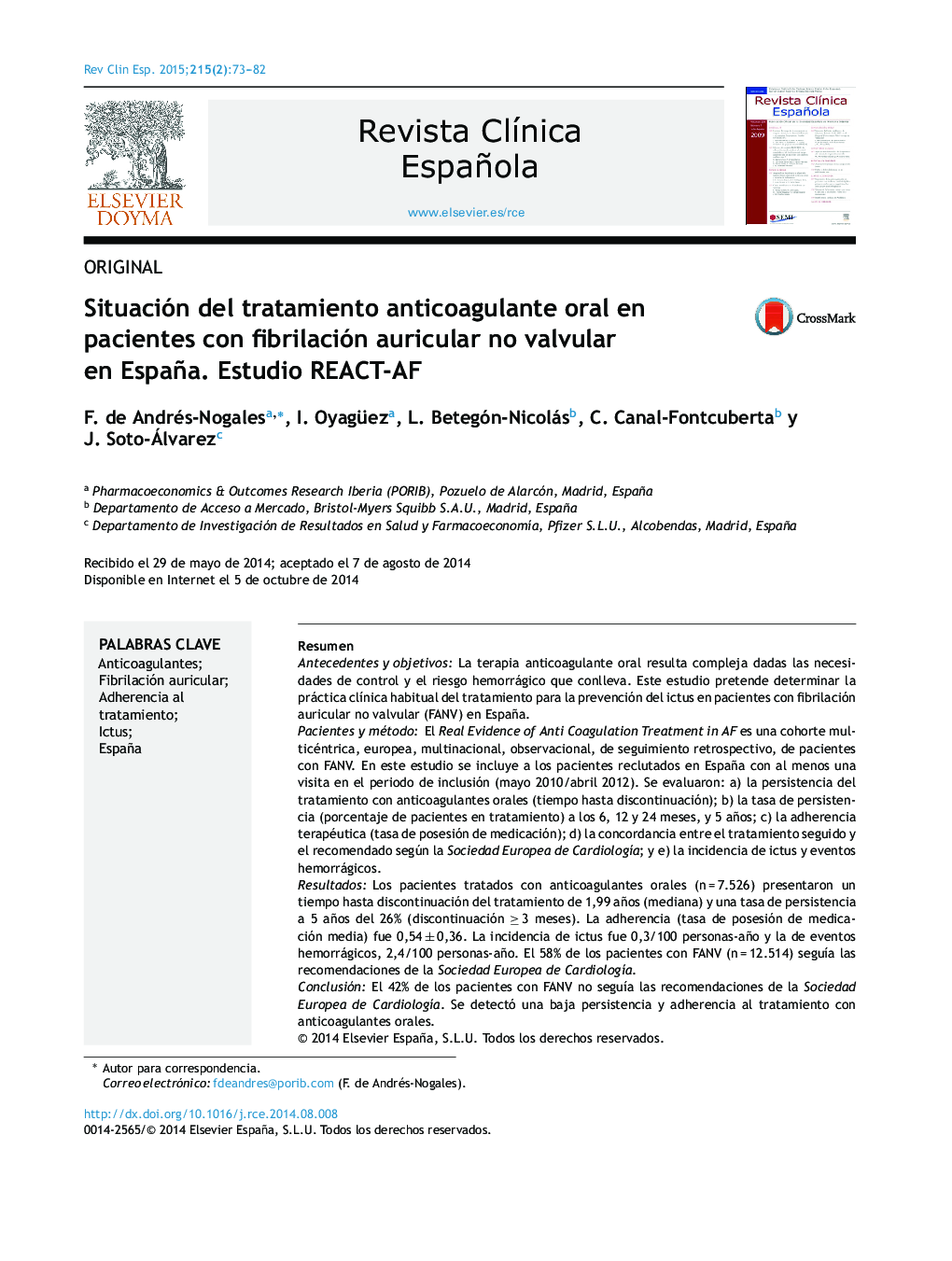| Article ID | Journal | Published Year | Pages | File Type |
|---|---|---|---|---|
| 3827005 | Revista Clínica Española | 2015 | 10 Pages |
ResumenAntecedentes y objetivosLa terapia anticoagulante oral resulta compleja dadas las necesidades de control y el riesgo hemorrágico que conlleva. Este estudio pretende determinar la práctica clínica habitual del tratamiento para la prevención del ictus en pacientes con fibrilación auricular no valvular (FANV) en España.Pacientes y métodoEl Real Evidence of Anti Coagulation Treatment in AF es una cohorte multicéntrica, europea, multinacional, observacional, de seguimiento retrospectivo, de pacientes con FANV. En este estudio se incluye a los pacientes reclutados en España con al menos una visita en el periodo de inclusión (mayo 2010/abril 2012). Se evaluaron: a) la persistencia del tratamiento con anticoagulantes orales (tiempo hasta discontinuación); b) la tasa de persistencia (porcentaje de pacientes en tratamiento) a los 6, 12 y 24 meses, y 5 años; c) la adherencia terapéutica (tasa de posesión de medicación); d) la concordancia entre el tratamiento seguido y el recomendado según la Sociedad Europea de Cardiología; y e) la incidencia de ictus y eventos hemorrágicos.ResultadosLos pacientes tratados con anticoagulantes orales (n = 7.526) presentaron un tiempo hasta discontinuación del tratamiento de 1,99 años (mediana) y una tasa de persistencia a 5 años del 26% (discontinuación ≥ 3 meses). La adherencia (tasa de posesión de medicación media) fue 0,54 ± 0,36. La incidencia de ictus fue 0,3/100 personas-año y la de eventos hemorrágicos, 2,4/100 personas-año. El 58% de los pacientes con FANV (n = 12.514) seguía las recomendaciones de la Sociedad Europea de Cardiología.ConclusiónEl 42% de los pacientes con FANV no seguía las recomendaciones de la Sociedad Europea de Cardiología. Se detectó una baja persistencia y adherencia al tratamiento con anticoagulantes orales.
Background and objectivesOral anticoagulant therapy is complex due to the need for control and the hemorrhagic risk the therapy entails. This study aims to determine the standard clinical practice in the treatment for preventing stroke in patients with nonvalvular atrial fibrillation (NVAF) in Spain.Patients and methodThe Real Evidence of Anti Coagulation Treatment in AF is a European, multicenter, multinational, observational, retrospectively monitored cohort of patients with NVAF. This study included patients recruited in Spain with at least one visit during the period of inclusion (May 2010/April 2012). The study evaluated the following: a) persistence of oral anticoagulant treatment (time to discontinuation); b) persistence rate (% of patients in treatment) at 6, 12 and 24 months and at 5 years; c) therapeutic compliance (medication possession ratio); d) the correlation between the treatment followed and that recommended by the European Society of Cardiology; and the incidence of stroke and hemorrhagic events.ResultsThe patients treated with oral anticoagulants (n = 7,526) had a median time to discontinuation of treatment of 1.99 years and a persistence rate at 5 years of 26% (discontinuation ≥ 3 months). The compliance (mean MPR) was 0.54 ± 0.36. The incidence of stroke was 0.3/100 person-years, and the incidence of hemorrhagic events was 2.4/100 person-years. Fifty-eight percent of the patients with NVAF (n = 12,514) followed the recommendations of the European Society of Cardiology.ConclusionForty-two percent of the patients with NVAF did not follow the recommendations of the European Society of Cardiology. We detected low persistence and treatment compliance rates for oral anticoagulants.
